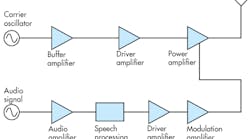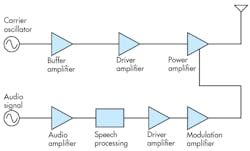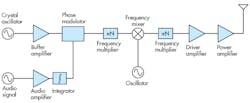The Differences Between Transmitter Types, Part 1
Download this article in PDF format.
A transmitter is no doubt a critical part of any communications system. Simply put, the purpose of a transmitter is to transmit signals that contain some form of information. The explosion of mobile communications means that many people actually have a transmitter right in their pocket. In addition, many people today still listen to AM and FM radio stations, which obviously require transmitters to broadcast programs. Moreover, aircraft, radar systems, and many other applications depend on transmitters to enable communication.
This article, Part 1 of a two-part series, provides a general overview of transmitters, including discussion of classical AM and FM transmitters. Part 2, which will appear in the April issue of Microwaves & RF, will focus on additional transmitter implementations, as well as delve into modern digital techniques.
As its name implies, the general purpose of a transmitter is to transmit signals. These signals contain information, which can be audio, video, or data. In essence, a transmitter launches signals into the air via a transmitting antenna. After traveling some distance, the transmitted signal eventually reaches the receiving antenna of a receiver. The receiver then deciphers and processes the information contained in the transmitted signal.
A transmitter’s functionality is achieved through a series of steps. First, a carrier signal must be generated. The actual information signal then modulates this carrier signal. Thus, the information signal is often referred to as the modulating signal (it is also occasionally called the message signal). The carrier signal essentially “carries” the modulation information.
Once the carrier signal is modulated, it is amplified to a level sufficient to allow for transmission over the required distance. The final amplification stage is realized by a power amplifier (PA), an important component in any transmitter. Once the PA amplifies the signal, it is fed to the transmitter’s antenna and subsequently launched.
The PA’s performance depends on the requirements of the specific application. Thus, any transmitter has its own specific power requirements. For example, base-station power requirements have been increasing in recent years, with power levels expected to be as high as 100 W in the future. For AM radio broadcasting, power levels of transmitted signals reach the kilowatt range.
Of course, many transmitter implementations are possible. Take, for instance, the large number of modulation techniques currently being employed. However, the process described here can be considered a very general overview of a transmitter’s functionality.
As mentioned, AM and FM broadcasting have been exploited for many years. AM and FM modulation are both forms of analog modulation. However, much of today’s wireless communication takes advantage of digital modulation techniques. This will be discussed in greater detail in Part 2.
AM Transmitters
AM broadcasting dates back to the early part of the 20th Century. In the U.S., AM radio broadcasting utilizes carrier frequencies ranging from 540 to 1,700 kHz at 10-kHz intervals. AM extends beyond radio broadcasting—for example, aircraft communication also uses AM.
With AM modulation, the modulating, or audio, signal varies the instantaneous amplitude of the carrier signal. In effect, the instantaneous value of the carrier signal’s amplitude is determined by the instantaneous amplitude of the modulating signal.
Figure 1 shows a block diagram of an AM transmitter implementation.1 This configuration is known as a high-level AM transmitter. An oscillator generates the carrier signal, which is amplified by a buffer amplifier and then again by a driver amplifier. The driver amplifier must raise the signal’s power level to an amount that is sufficient enough to drive the final-stage PA.
Meanwhile, an audio signal is generated and then amplified. Once amplified, the audio signal is fed to a speech-processing circuit to ensure that only the desired frequencies are passed. Next, a driver amplifier boosts the signal’s power level in order to drive the high-power modulation amplifier.
The high-power modulation amplifier’s output signal then modulates the final-stage PA. Now, the presence of this audio signal, as well as the carrier signal driving the input of the PA, results in a high-power, AM modulated signal at the PA’s output. This AM signal is then fed to an antenna and launched. Eventually, an AM receiver receives the signal, and in turn recovers the audio information.
FM Transmitters
Like AM, FM radio broadcasting has been in play for many years. In the U.S., FM radio broadcasting operates in the 88- to 108-MHz frequency band. With FM modulation, the carrier frequency varies in proportion with the amplitude of the modulating signal. The amount that the frequency varies is known as the frequency deviation. For FM radio broadcasting in the U.S., maximum frequency deviation is ±75 kHz.
Figure 2 shows a block diagram of one possible FM transmitter implementation. This particular transmitter takes advantage of what is known as the indirect method. A crystal oscillator generates the carrier signal, which is then amplified by a buffer amplifier before reaching a phase modulator.
Meanwhile, an audio signal is generated and amplified, and subsequently arrives at the phase modulator. The presence of both the audio and carrier signals now results in an FM signal at the output of the phase modulator.
In the transmitter shown, the crystal oscillator generates the carrier signal at a frequency lower than the final output frequency. Hence, the FM signal must pass through a frequency multiplier followed by a mixer and then another frequency multiplier. This process takes place so that the signal converts to the desired final output frequency while also attaining the required frequency deviation. That FM signal is amplified by a driver amplifier and then again by the PA before being fed to the antenna for transmission. The transmitted signal eventually reaches an FM receiver, which recovers the information.
Part 2 of this series will discuss other transmitter varieties, such as single-sideband (SSB) transmitters. It will also delve into the digital techniques used to enable modern wireless technology. Unlike AM and FM radio transmitters, many of today’s transmitters actually transmit digitally modulated signals.
Reference:
1. Frenzel, Louis E., Principles of Electronic Communication Systems, Fourth Edition, McGraw Hill, 2016.


